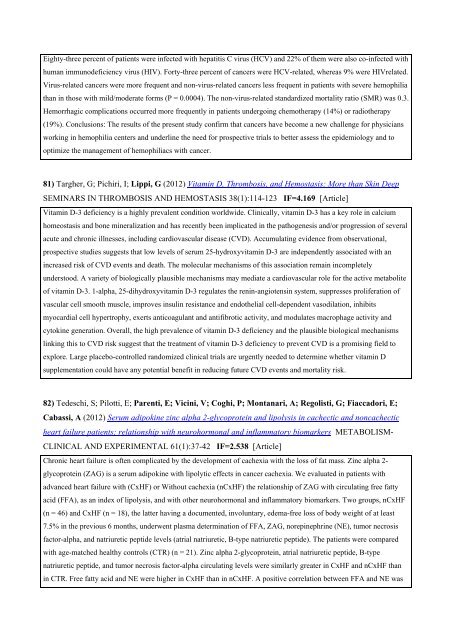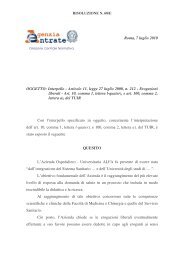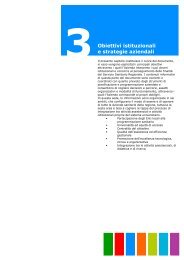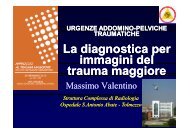COLLEGIO DI DIREZIONE - Azienda Ospedaliera di Parma
COLLEGIO DI DIREZIONE - Azienda Ospedaliera di Parma
COLLEGIO DI DIREZIONE - Azienda Ospedaliera di Parma
Create successful ePaper yourself
Turn your PDF publications into a flip-book with our unique Google optimized e-Paper software.
Eighty-three percent of patients were infected with hepatitis C virus (HCV) and 22% of them were also co-infected with<br />
human immunodeficiency virus (HIV). Forty-three percent of cancers were HCV-related, whereas 9% were HIVrelated.<br />
Virus-related cancers were more frequent and non-virus-related cancers less frequent in patients with severe hemophilia<br />
than in those with mild/moderate forms (P = 0.0004). The non-virus-related standar<strong>di</strong>zed mortality ratio (SMR) was 0.3.<br />
Hemorrhagic complications occurred more frequently in patients undergoing chemotherapy (14%) or ra<strong>di</strong>otherapy<br />
(19%). Conclusions: The results of the present study confirm that cancers have become a new challenge for physicians<br />
working in hemophilia centers and underline the need for prospective trials to better assess the epidemiology and to<br />
optimize the management of hemophiliacs with cancer.<br />
81) Targher, G; Pichiri, I; Lippi, G (2012) Vitamin D, Thrombosis, and Hemostasis: More than Skin Deep<br />
SEMINARS IN THROMBOSIS AND HEMOSTASIS 38(1):114-123 IF=4.169 [Article]<br />
Vitamin D-3 deficiency is a highly prevalent con<strong>di</strong>tion worldwide. Clinically, vitamin D-3 has a key role in calcium<br />
homeostasis and bone mineralization and has recently been implicated in the pathogenesis and/or progression of several<br />
acute and chronic illnesses, inclu<strong>di</strong>ng car<strong>di</strong>ovascular <strong>di</strong>sease (CVD). Accumulating evidence from observational,<br />
prospective stu<strong>di</strong>es suggests that low levels of serum 25-hydroxyvitamin D-3 are independently associated with an<br />
increased risk of CVD events and death. The molecular mechanisms of this association remain incompletely<br />
understood. A variety of biologically plausible mechanisms may me<strong>di</strong>ate a car<strong>di</strong>ovascular role for the active metabolite<br />
of vitamin D-3. 1-alpha, 25-<strong>di</strong>hydroxyvitamin D-3 regulates the renin-angiotensin system, suppresses proliferation of<br />
vascular cell smooth muscle, improves insulin resistance and endothelial cell-dependent vaso<strong>di</strong>lation, inhibits<br />
myocar<strong>di</strong>al cell hypertrophy, exerts anticoagulant and antifibrotic activity, and modulates macrophage activity and<br />
cytokine generation. Overall, the high prevalence of vitamin D-3 deficiency and the plausible biological mechanisms<br />
linking this to CVD risk suggest that the treatment of vitamin D-3 deficiency to prevent CVD is a promising field to<br />
explore. Large placebo-controlled randomized clinical trials are urgently needed to determine whether vitamin D<br />
supplementation could have any potential benefit in reducing future CVD events and mortality risk.<br />
82) Tedeschi, S; Pilotti, E; Parenti, E; Vicini, V; Coghi, P; Montanari, A; Regolisti, G; Fiaccadori, E;<br />
Cabassi, A (2012) Serum a<strong>di</strong>pokine zinc alpha 2-glycoprotein and lipolysis in cachectic and noncachectic<br />
heart failure patients: relationship with neurohormonal and inflammatory biomarkers METABOLISM-<br />
CLINICAL AND EXPERIMENTAL 61(1):37-42 IF=2.538 [Article]<br />
Chronic heart failure is often complicated by the development of cachexia with the loss of fat mass. Zinc alpha 2glycoprotein<br />
(ZAG) is a serum a<strong>di</strong>pokine with lipolytic effects in cancer cachexia. We evaluated in patients with<br />
advanced heart failure with (CxHF) or Without cachexia (nCxHF) the relationship of ZAG with circulating free fatty<br />
acid (FFA), as an index of lipolysis, and with other neurohormonal and inflammatory biomarkers. Two groups, nCxHF<br />
(n = 46) and CxHF (n = 18), the latter having a documented, involuntary, edema-free loss of body weight of at least<br />
7.5% in the previous 6 months, underwent plasma determination of FFA, ZAG, norepinephrine (NE), tumor necrosis<br />
factor-alpha, and natriuretic peptide levels (atrial natriuretic, B-type natriuretic peptide). The patients were compared<br />
with age-matched healthy controls (CTR) (n = 21). Zinc alpha 2-glycoprotein, atrial natriuretic peptide, B-type<br />
natriuretic peptide, and tumor necrosis factor-alpha circulating levels were similarly greater in CxHF and nCxHF than<br />
in CTR. Free fatty acid and NE were higher in CxHF than in nCxHF. A positive correlation between FFA and NE was












